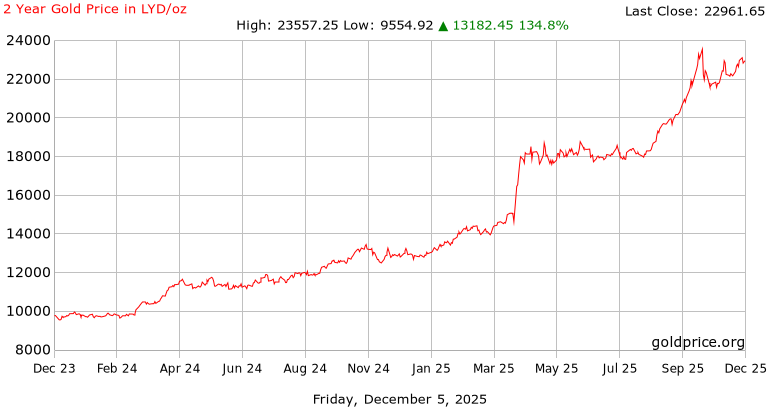Gold Price Libya
(Libyan Dinar)
Conversion : 1 troy ounce = 31.1034768 grams
Libyan Dinar 24 Hour Spot Gold and Silver Price
Libyan Dinar Gold Price History Charts
To learn about our gold price data
Gold Price Libya
Libya is located in Northern Africa and is bordered by Egypt, Sudan, Chad, Niger, Algeria and Tunisia. Libya has an area of about 700,000 square miles, making it the fourth largest country in Africa and the 16th largest in the world. Libya became independent as a kingdom back in 1951, and the nation was ruled by King Idris I until he was overthrown in a coup in 1969. The leader of the coup, Muammar Gaddafi, ruled the country from The Libyan Cultural Revolution in 1973 until his death in the Libyan Civil War in 2011. The country has been relatively unstable since that time. The capital of Libya is Tripoli and the country has approximately six million people.
The official currency of the country is the Libyan Dinar. Introduced in 1971, the Libyan Dinar is subdivided into 1000 dirham. The currency is issued and controlled by the Central Bank of Libya. The central bank not only manages the nation’s currency, but also oversees its banking system and regulates credit.
If you are looking to buy gold in Libya or just want to check live gold prices, you will see the metal quoted in the local currency. Oftentimes, prices are also available in other key global currencies such as U.S. Dollars, euros, Great British Pounds or Japanese Yen. Prices are most often quoted by the ounce, gram or kilo.
The Libyan economy is heavily dependent on petroleum. Exports of petroleum make up the vast majority of export earnings and over half of the nation’s GDP. Libya is a member of OPEC and it has the largest oil reserves in Africa. Libya’s primary export partners include China, France, Italy, Syria, Germany, The Netherlands and Spain.
Although some Libyan collectible coins may be available, the nation has not been a major producer of bullion coins or bars. Although collectible coins may add value to a portfolio or collection, they are not the best way to acquire a significant amount of gold bullion.
For those looking to maximize their investment capital, gold bars and bullion coins may be the best way to go. Gold bullion bars, in particular, may offer the most cost effective way to acquire gold. Bars are available in two major types: Minted bars and cast bars. Minted bars have a sleek and shiny look and are made by taking blank bars and stamping them. Cast bars, on the other hand, are made by pouring liquid gold into molds and then allowing the metal to cool. Due to the way they are made, no two cast bars will look exactly the same. Cast bars may also be the least expensive for refiners to produce, and those cost savings may equal lower overall premiums for purchasers.
Gold coins are considered good, legal tender by their issuing mint, and often have significantly more detail than bullion bars. Because of these factors, coins often carry higher per-ounce premiums compared to bullion bars.Although coins may be good, legal tender, their value is derived primarily from their metal content.















